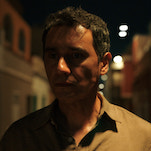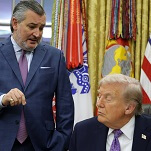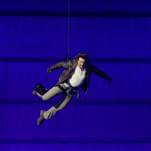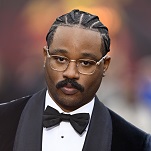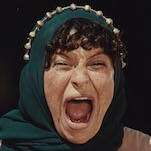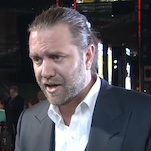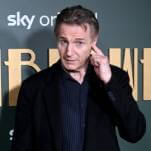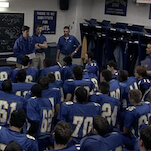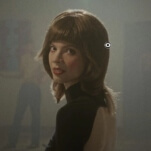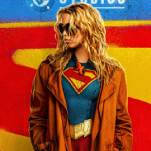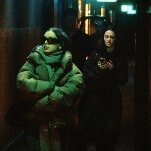Horror is one of the most accommodating and resilient genres, commercially speaking. And yet a lot of independent horror films, be they chock-full of blood and gore or of the more psychological and coiled variety, still exude a certain “calling-card” ethos—the sheer joy of their makers can feel almost palpable, and sometimes equal to the weight of the actual narrative unfolding onscreen. This makes The Dead Thing all the more remarkable. A well-crafted, slow-burn art-horror offering that falls somewhere between doomed character study and moody ghost story, the movie exudes an unerring confidence in its own skin. It’s not an eager group of individual showcases or a proof-of-concept for another project, but a creatively executed rumination on universally relevant themes.
While not without its faults, The Dead Thing literalizes the hold of toxic relationships and trauma-bonding in a way that effectively reads as a metaphor about the despair and damage of codependency, while also remaining elastic enough to invite multiple related interpretations. Set in Los Angeles, the story centers on twentysomething Alex (Blu Hunt), who’s trapped in a series of meaningless hook-ups. Once close with her roommate Cara (Katherine Hughes), she now avoids her entirely, preferring isolation. When not working alongside Mark (Joey Millin) at a soulless job scanning documents, Alex scrolls the dating app Friction and sits in the dark, blasting herself with a therapeutic green light. Her life feels like it’s slowly circling the drain.
When one of her Friction flings, Kyle (Ben Smith-Petersen), awakens the tingle of a deeper bond, Alex is cautiously optimistic. He seemingly feels something too, but after Kyle ghosts her and Alex later spots him out with another woman, she tries to make sense of his behavior. While new co-worker Chris (John Karna) has some success puncturing Alex’s morose veneer, her more private obsessions begin to take their toll.
As the driving force behind The Dead Thing’s loose-grip intrigue, Hunt is excellent. Eschewing any of the markers of sympathetic identification that a lot of young actors deploy in an attempt to make their character read as more likable, Hunt instead consistently deadens her expressions. Still, her eyes and thoughtful silences convey vast oceans of feeling. It’s a well-calibrated, inward-facing performance—the exception to this found in coital close-ups (of which there are quite a few) that serve up a fascinating inventory of her character’s relationship with amorous abandon.
Hunt plays Alex in such a muted way (clinically depressed, most likely) that the occasional scenes where she loosens up (her date with Kyle and its aftermath, an offbeat moment of levity with Mark, two workplace meals with Chris) land with a crystalline brilliance. In these moments, Hunt shows off who Alex could be (and maybe really is). It’s a smartly written part, and played even smarter.
On the other side, stuntman-turned-actor Smith-Petersen (he was a Warboy in both Mad Max: Fury Road and Furiosa) ably communicates a certain vulnerability, but the limits of his range are somewhat evident. These shortcomings in turn require any substantive investment in Kyle to lean generously upon the film’s framing of the character.
The Dead Thing requires a viewer’s acceptance and embrace of a decidedly low-fi vibe, where the plotting is rudder-steered rather than propulsively driven. Those expecting gore or even consistently meted out scares will be disappointed. That said, when a film’s pacing is purposeful and its lead character interesting, surface-level action matters a lot less than one might think.
The movie does eventually reconnect Alex and Kyle. He claims not to remember her, but is that really truthful or merely a mechanism of emotional manipulation? It’s here in its final act that the movie’s intellectual and psychological grip slackens, even as it finally makes a move to present more overt danger. As it becomes clearer, in both scripting and performance, that Kyle will only ever represent an idea rather than a fleshed-out character, an imbalance develops. A couple attempts to deliver stylized and more typically genre-based pulse-quickeners land weakly, and The Dead Thing hits a wall.
Where the film connects most readily, though, is in its low-budget technical package, and the material’s thematic fit with both the vision and execution of director Elric Kane and his co-writer Webb Wilcoxen. Economic in dialogue (Alex doesn’t speak until roughly nine minutes into the movie) and with an emphasis on sparse and dim nighttime spaces, The Dead Thing conjures a lonely world that mirrors the emotionally strip-mined mental state of its protagonist, its every visual set-up further grounding viewers. Cinematographer Ioana Vasile turns in gorgeous work, full of compelling frames. And while the movie isn’t explicitly color-coded, Kane, Vasile, and their team make evocative use of primary and secondary hues as more than simply a way to light scenes.
A parable of the vampiric way in which hurt or broken people can drain the essence of others in order to sustain themselves, and how one’s own trauma can feed complicity into that self-destructive loop, The Dead Thing is shot through with reflective unease more than horror or tension. That it largely avoids most of the showier instincts and commercial-minded choices of its core conceit makes it, ironically, a fine calling card for the talent involved.
Director: Elric Kane
Writers: Elric Kane, Webb Wilcoxen
Stars: Blu Hunt, Ben Smith-Petersen
Release Date: February 14, 2025 (Shudder)


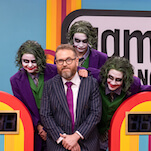
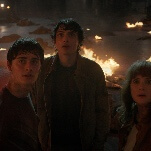
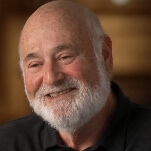

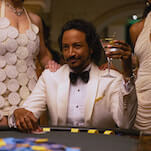

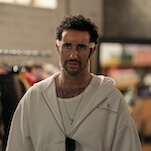
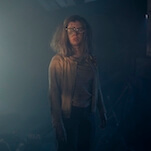
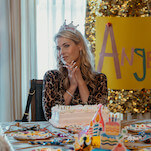
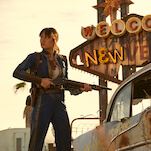

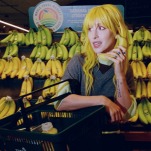





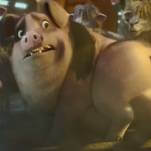


![HBO teases new Euphoria, Larry David, and much more in 2026 sizzle reel [Updated]](https://img.pastemagazine.com/wp-content/avuploads/2025/12/12100344/MixCollage-12-Dec-2025-09-56-AM-9137.jpg)


